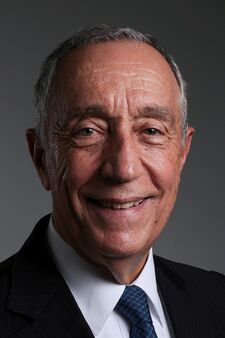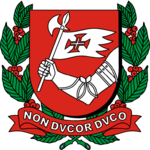President of Belmonte
| President of Belmonte | |
|---|---|
| Presidente de Belmonte (Iustan) | |
 Presidential flag of Belmonte | |
| Style | His/Her Excellency Mr/Mrs. President |
| Status | Chief of State |
| Member of | State Council National Defence Council |
| Residence | Mascarenhas Palace, Castelonovo |
| Nominator | Self-nomination |
| Appointer | Electoral College |
| Term length | five years, renewable |
| Constituting instrument | Constitution |
| Precursor | Captain-Regent |
| Formation | 18 April 1819 |
| First holder | Jorge Aranha |
| Salary | ₡68,837 |
The President of Belmonte (Iustan: Presidente de Belmonte), officially the President of the United Republic of Belmonte (Iustan: Presidente da República Unida de Belmonte), is the chief of state of Belmonte and therefore the highest officer in the country, as well as the commander-in-chief of the armed forces.
The origins of the presidential office could be traced back to the Federalist Revolt, where many members of the Belmontese elite of the time such as politicians, philosophers, merchants and military officers, unsatisfied with the current confederalist regime that they saw as weak and antiquated, started a revolt to establish a federalist republic with strong national institutions which received the support of a considerable majority of the population and the army, with the office being officially created in 1819. Initially, the president was both the chief of state and chief of government as well since Belmonte was a presidential republic, with the presidency slowly beginning to become an extremely authoritarian office thanks to its wide range of powers which made the National Congress left without any authority. Due to that, the Belmontese Revolution broke out in 1836, and a new constitution heavily limited its powers and established a parliamentary system of government. Since then, the president primarily serves as a figurehead without any practical or governmental power, although it still maintains some of them.
According to the 1836 constitution, it’s the responsibility of the president of command the armed forces; appoint and dismiss the prime minister and its cabinet; dissolve the parliament; convoke new elections; represent the State in international and domestic meetings; enact new legislation; order pardons; appoint ambassadors among others. The president is elected indirectly through the Electoral College, where it is needed at least half of the votes to be elected for a mandate of five years that could be renewable. As a way to maintain the office as much impartial as possible, it’s strictly prohibited that the president in office remains affiliated or shows support to any political party or association of its kind.
The president is also responsible for lead and manage the State Council of the Republic and the National Defence Council.
The current holder of the office is Caetano Villa-Lobos, who assumed the presidency at 15 of September of 2010.

